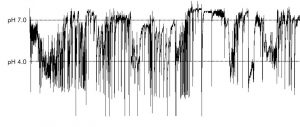What is a pH impedance study?
A pH impedance study (sometimes called esophageal impedance or pH impedance probe) is a diagnostic test used to gather information about your child’s condition. It is not a treatment or intervention. This test measures how often fluid comes up into your child’s food pipe, also called called the esophagus. The study also measures the pH (acidity) of the fluid coming up from the stomach into the esophagus. A pH impedance study can provide a lot of information, including the frequency and length of acidic and non-acidic reflux episodes. This information helps relate a patient’s symptoms to reflux episodes and helps guide proper treatment.
Why might a child need a pH impedance test?
A pH impedance study may be used to help diagnose gastroesophageal reflux, determine if acid suppression treatment therapy is effective, and to investigate symptoms that may be caused by gastroesophageal reflux, such as feeding aversion, cough, or discomfort.
What happens before a pH impedance test?
Your provider will provide specific instructions before the test. In some cases, your provider may want to stop any acid suppression medication your child is taking. Please consult with your provider before stopping any medications.
Placing or keeping a pH probe in place should not cause pain, but your child may feel anxious about the test. It is helpful to talk to your healthcare professional about this ahead of time. Depending on the healthcare institution, child life specialists may be available to make your child feel more comfortable. Sometimes providers can give your child a small amount of medication to ease anxiety during the procedure.
How is a pH impedance test performed?
The test is performed by placing a small plastic tube in one of your child’s nostrils and pushing the tube down into the esophagus. The tube has sensors along its sides that help gather information.
• In some cases, your child may be sedated if he or she is undergoing another procedure, such as an endoscopy. In other cases, the probe is inserted while your child is awake, usually in the hospital or provider’s office. A chest X-ray is sometimes taken after the tube is inserted to confirm that the tube and sensors are in the correct location.
The tube is connected to a portable recorder that your child will carry around during the study, which usually lasts 24–48 hours.
• Different hospitals have different recorders. Your provider’s office will go over the recorder and how to use it.
Depending on your child’s age and their provider’s recommendation, your child may be admitted to the hospital for the duration of the study to ensure the probe stays in place.
What is allowed during the test?
Your child should continue usual activities, including eating and sleeping. A diary of symptoms (crying, coughing, chest pain, refusing to eat) helps determine whether acid in the esophagus is contributing to your child’s symptoms.
What happens after a pH impedance test?
After the test, your provider will direct you to remove any tape used to secure the tube in place and remove the tube. Return the recording box along with the symptom diary to your provider’s office. If your child is admitted to the hospital for the study, the probe will be removed and you can take your child home. Your provider will read the entire 24–48-hour log and analyze the information.
What are the risks of a pH impedance study?
Placing the probe can cause gagging and can be uncomfortable for your child. However, this usually goes away quickly after the probe is placed. Your child may vomit when the probe is placed. A small amount of bleeding may occur from the nose, throat, or tonsils as the probe is placed. This bleeding is usually minor. Coughing may occur if the probe goes into the windpipe (called the trachea). This is rare and can be seen on the chest X-ray. Coughing will go away when the probe is removed. The probe may come out because of coughing, vomiting, or the child pulling it out. If this happens, the probe will need to be put back in.
What should we watch for after the test, and when should we seek medical advice?
In most cases, your child will feel normal after the test. Some children might experience discomfort in their throat when swallowing, although usually goes away within a couple of hours after the probe is removed. You should contact your provider if your child has persistent pain.
Image
A pH probe tracing may look like this:
Every downward turn of the curve reflects the presence of acid in the esophagus. A score can be calculated to help determine how abnormal the pH probe study is.
References
Rudolph, C., & Vandenplas, Y. (2009). Pediatric gastroesophageal reflux clinical practice guidelines: Joint recommendations of the North American Society for Pediatric Gastroenterology, Hepatology, and Nutrition (NASPGHAN). Journal of Pediatric Gastroenterology and Nutrition 49:498-547.
Shin, M. (2014). Esophgeal pH and combined impedance-pH monitoring in children. Pediatric Gastroenterology, Hepatology and Nutrition 17:13-22.
Authors: K. Rowell, FNP / E. Burch, CPNP
Reviewed: Andrea M. Glaser, MD 2/6/2020
IMPORTANT REMINDER: This information from the North American Society for Pediatric Gastroenterology, Hepatology and Nutrition (NASPGHAN) is intended only to provide general educational information as a definitive basis for diagnosis or treatment in any particular case. It is very important that you consult your doctor about your specific condition.





